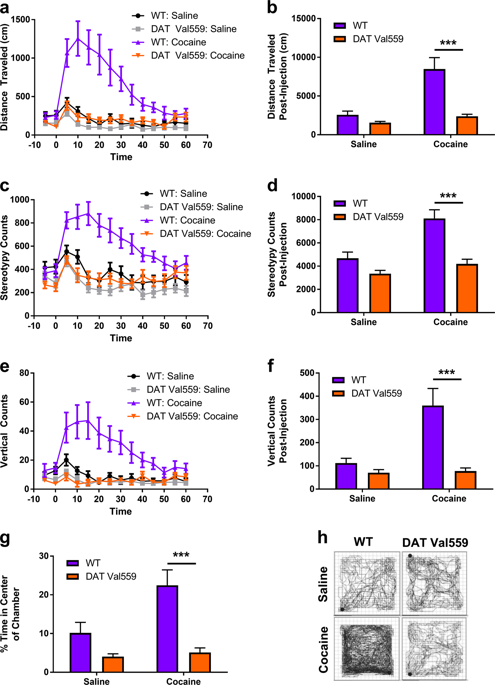当前位置:
X-MOL 学术
›
Neuropsychopharmacology
›
论文详情
Our official English website, www.x-mol.net, welcomes your
feedback! (Note: you will need to create a separate account there.)
Serotonin transporter inhibition and 5-HT2C receptor activation drive loss of cocaine-induced locomotor activation in DAT Val559 mice.
Neuropsychopharmacology ( IF 6.6 ) Pub Date : 2018-12-21 , DOI: 10.1038/s41386-018-0301-8 Adele Stewart 1 , Gwynne L Davis 1, 2 , Paul J Gresch 1, 3 , Rania M Katamish 1 , Rodeania Peart 4 , Maximilian J Rabil 1 , Raajaram Gowrishankar 1, 2, 5 , F Ivy Carroll 6 , Maureen K Hahn 1, 3 , Randy D Blakely 1, 3
Neuropsychopharmacology ( IF 6.6 ) Pub Date : 2018-12-21 , DOI: 10.1038/s41386-018-0301-8 Adele Stewart 1 , Gwynne L Davis 1, 2 , Paul J Gresch 1, 3 , Rania M Katamish 1 , Rodeania Peart 4 , Maximilian J Rabil 1 , Raajaram Gowrishankar 1, 2, 5 , F Ivy Carroll 6 , Maureen K Hahn 1, 3 , Randy D Blakely 1, 3
Affiliation

|
Dopamine (DA) signaling dysfunction is believed to contribute to multiple neuropsychiatric disorders including attention-deficit/hyperactivity disorder (ADHD). The rare DA transporter (DAT) coding substitution Ala559Val found in subjects with ADHD, bipolar disorder and autism, promotes anomalous DA efflux in vitro and, in DAT Val559 mice, leads to increased reactivity to imminent handling, waiting impulsivity, and enhanced motivation for reward. Here, we report that, in contrast to amphetamine and methylphenidate, which induce significant locomotor activation, cocaine administration to these mice elicits no locomotor effects, despite retention of conditioned place preference (CPP). Additionally, cocaine fails to elevate extracellular DA. Given that amphetamine and methylphenidate, unlike cocaine, lack high-affinity interactions with the serotonin (5-HT) transporter (SERT), we hypothesized that the lack of cocaine-induced hyperlocomotion in DAT Val559 mice arises from SERT blockade and augmented 5-HT signaling relative to cocaine actions on wildtype animals. Consistent with this idea, the SERT blocker fluoxetine abolished methylphenidate-induced locomotor activity in DAT Val559 mice, mimicking the effects seen with cocaine. Additionally, a cocaine analog (RTI-113) with greater selectivity for DAT over SERT retains locomotor activation in DAT Val559 mice. Furthermore, genetic elimination of high-affinity cocaine interactions at SERT in DAT Val559 mice, or specific inhibition of 5-HT2C receptors in these animals, restored cocaine-induced locomotion, but did not restore cocaine-induced elevations of extracellular DA. Our findings reveal a significant serotonergic plasticity arising in the DAT Val559 model that involves enhanced 5-HT2C signaling, acting independently of striatal DA release, capable of suppressing the activity of cocaine-sensitive motor circuits.
中文翻译:

5-羟色胺转运蛋白抑制和 5-HT2C 受体激活导致 DAT Val559 小鼠中可卡因诱导的运动激活丧失。
多巴胺 (DA) 信号功能障碍被认为会导致多种神经精神疾病,包括注意力缺陷/多动障碍 (ADHD)。在患有多动症、双相情感障碍和自闭症的受试者中发现的罕见 DA 转运蛋白 (DAT) 编码替代 Ala559Val 在体外促进异常 DA 流出,并且在 DAT Val559 小鼠中导致对即将发生的处理、等待冲动和增强奖励动机的反应性增加. 在这里,我们报告说,与诱导显着运动激活的苯丙胺和哌醋甲酯相反,尽管保留了条件性位置偏爱 (CPP),但对这些小鼠施用可卡因不会引起运动效应。此外,可卡因不能提高细胞外 DA。鉴于苯丙胺和哌醋甲酯与可卡因不同,由于缺乏与血清素 (5-HT) 转运蛋白 (SERT) 的高亲和力相互作用,我们假设 DAT Val559 小鼠缺乏可卡因诱导的过度运动是由于 SERT 阻断和相对于可卡因对野生动物的作用增强的 5-HT 信号传导。与这个想法一致,SERT 阻滞剂氟西汀消除了 DAT Val559 小鼠中哌醋甲酯诱导的运动活动,模仿了可卡因所见的效果。此外,与 SERT 相比,对 DAT 具有更高选择性的可卡因类似物 (RTI-113) 在 DAT Val559 小鼠中保留了运动激活。此外,在 DAT Val559 小鼠的 SERT 中遗传消除高亲和力可卡因相互作用,或在这些动物中特异性抑制 5-HT2C 受体,恢复了可卡因诱导的运动,但没有恢复可卡因诱导的细胞外 DA 升高。
更新日期:2019-01-26
中文翻译:

5-羟色胺转运蛋白抑制和 5-HT2C 受体激活导致 DAT Val559 小鼠中可卡因诱导的运动激活丧失。
多巴胺 (DA) 信号功能障碍被认为会导致多种神经精神疾病,包括注意力缺陷/多动障碍 (ADHD)。在患有多动症、双相情感障碍和自闭症的受试者中发现的罕见 DA 转运蛋白 (DAT) 编码替代 Ala559Val 在体外促进异常 DA 流出,并且在 DAT Val559 小鼠中导致对即将发生的处理、等待冲动和增强奖励动机的反应性增加. 在这里,我们报告说,与诱导显着运动激活的苯丙胺和哌醋甲酯相反,尽管保留了条件性位置偏爱 (CPP),但对这些小鼠施用可卡因不会引起运动效应。此外,可卡因不能提高细胞外 DA。鉴于苯丙胺和哌醋甲酯与可卡因不同,由于缺乏与血清素 (5-HT) 转运蛋白 (SERT) 的高亲和力相互作用,我们假设 DAT Val559 小鼠缺乏可卡因诱导的过度运动是由于 SERT 阻断和相对于可卡因对野生动物的作用增强的 5-HT 信号传导。与这个想法一致,SERT 阻滞剂氟西汀消除了 DAT Val559 小鼠中哌醋甲酯诱导的运动活动,模仿了可卡因所见的效果。此外,与 SERT 相比,对 DAT 具有更高选择性的可卡因类似物 (RTI-113) 在 DAT Val559 小鼠中保留了运动激活。此外,在 DAT Val559 小鼠的 SERT 中遗传消除高亲和力可卡因相互作用,或在这些动物中特异性抑制 5-HT2C 受体,恢复了可卡因诱导的运动,但没有恢复可卡因诱导的细胞外 DA 升高。











































 京公网安备 11010802027423号
京公网安备 11010802027423号